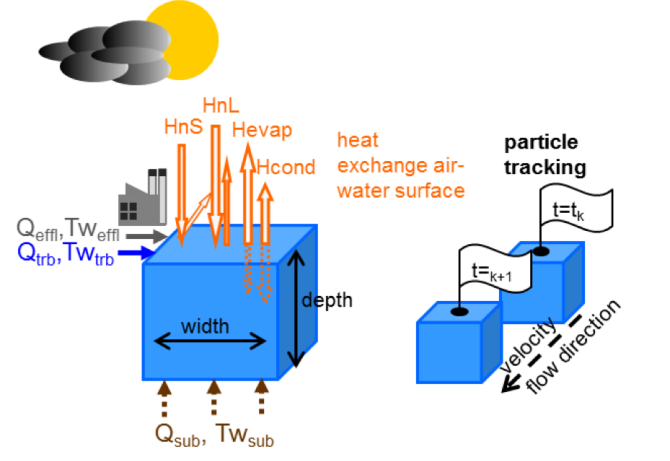RBM
RBM was previously modified for application on a worldwide level and to include effects of heat effluents from thermoelectric power plants and reservoir impacts on water temperature (van Vliet et al., 2012a). RBM uses output from the Variable Infiltration Capacity (VIC) hydrological model. The VIC-RBM modelling framework is applied on a 1/2° x 1/2° spatial resolution globally and was used to study impacts of climate change (Figure 2) (van Vliet et al., 2013a; van Vliet et al., 2016c) and impacts of thermal pollution (Raptis et al., 2016) on water temperatures globally. Global water temperature and streamflow projections of VIC-RBM were also used to quantify the consequences for cooling water use and electricity supply (van Vliet et al., 2016b; van Vliet et al., 2013c; van Vliet et al., 2016c; van Vliet et al., 2012b) and impacts on freshwater fish habitats globally (van Vliet et al., 2013b). VIC-RBM was also used for developing climate information services (van Vliet et al., 2015) and for quantifying impacts of recent droughts on power generation globally (van Vliet et al., 2016a).


Main publications
-
Global rivers warming up: impacts on cooling water use in the energy sector and freshwater ecosystems
Wageningen University. Promotor(en): Pavel Kabat, co-promotor(en): Fulco Ludwig - ISBN: 9789461734242 -
Coupled daily streamflow and water temperature modelling in large river basins
Hydrology and Earth System Sciences (2012), Volume: 16 - ISSN 1027-5606 - p. 4303-4321. -
Vulnerability of US and European electricity supply to climate change
Nature Climate Change (2012), Volume: 2 - ISSN 1758-678X - p. 676-681. -
Global River Discharge and Water Temperature under Climate Change
Global environmental change : human and policy dimensions (2013), Volume: 23, Issue: 2 - ISSN 0959-3780 - p. 450-464. -
Global streamflow and thermal habitats of freshwater fishes under climate change
Climatic Change (2013), Volume: 121, Issue: 4 - ISSN 0165-0009 - p. 739-754. -
European scale climate information services for water use sectors
Journal of Hydrology (2015), Volume: 528 - ISSN 0022-1694 - p. 503-513. -
Water constraints on European power supply under climate change: impacts on electricity prices
Environmental Research Letters (2013), Volume: 8, Issue: 3 - ISSN 1748-9326 -
Impacts of recent drought and warm years on water resources and electricity supply worldwide
Environmental Research Letters (2016), Volume: 11, Issue: 12 - ISSN 1748-9326 -
Multi-model assessment of global hydropower and cooling water discharge potential under climate change
Global environmental change : human and policy dimensions (2016), Volume: 40 - ISSN 0959-3780 - p. 156-170. -
Power-generation system vulnerability and adaptation to changes in climate and water resources
Nature Climate Change (2016), Volume: 6, Issue: 4 - ISSN 1758-678X - p. 375-380.